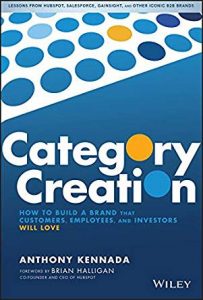When you’re building something new it may appear that you don’t easily fit into any clearly defined category. The existing players and analysts may want to box you in and give you a label of a better mousetrap of one or two categories. Yet, they may not really describe your vision and understanding of the future, and the problems you’re trying to solve.
Category creation is something that takes courage but as well might be the only really good option available. If you don’t find many (or any) competitors, nobody is covering your space in media, and there are only a very small number of people who get what you are doing but they are passionate about it the good news is that you might be onto something.
Salesforce is a classic example of a category creation company. In their early years they were really loud and clear about the coming cloud revolution. Their marketing was about the “end of software” to the extent that they used “no software” in their branding. At the time cloud computing category was as widely used as Amazon in the mid 90’s.
According to Kennada category creation is a business strategy where the company is focusing on marketing the category by focusing on the new problem in the industry more than the actual solutions for it. In practise, this means a choice where the company is educating the market and building a community and ecosystem around the new category.
This is a daunting task taking a lot of company resources for the public good that often at the outset seems to be used at the expense of the actual product marketing efforts. The upside is that a successful category building brands the company as the market leader with its share of the total market revenues. Google, Uber, AirBnb are examples of category builders.
A disruptive business strategy is the opposite of category building. It is executed towards an incumbent in the industry and positioned as something better than the existing solution to the problem in question. It uses the analogies and compares oneself to the existing status quo instead of creating a completely new paradigm in the market. Zoom vs. WebEx and Google Docs vs. MS Office are examples of this challenger positioning.
One of the oxymorons might be a category creator in an industry with one or more incumbents. Category creations can be recognised as a de facto strategy later but at the time it was just the obvious choice to build the market place and create the proper demand for the solution. Yet, sometimes fast followers are the ones taking the leading market position from the first movers, and history is full of examples of this behaviour.
Most of the content is about practicalities for building and getting inspiration for category creation. It also introduces business-to-human (B2H) as an approach to marketing and sales where the main focus are the people behind the companies and logos. Kennada sees that B2B and B2C marketing are merging towards unified B2H and customers are gravitating towards companies they admire and trust.
The philosophical aspect of B2H marketing concentrates on the individuals and helping them to solve problems and build relative connections among peers and mentors. The practical aspect can use many of the existing tools and means for targeted content and marketing.
Values, purpose and overall human-centric approach to business building is one central theme overall in the book. It may very well define this new business decade as well.

